African violets are one of the widespread flowering houseplants found in households. They are low maintenance and easy to grow.
Like all other plants, you need to take care of their basic requirements to keep them healthy. So this article is going to be about how to take care of your African violets.
The care routine for African violets is not complicated, and you can grow them easily.
African violets require a warm and semi-humid climate, proper and deep watering, indirect sunlight, and proper fertilization during their growing period.
We have compiled 12 care tips for African violets to help you take better care of these plants to get the best blooms.
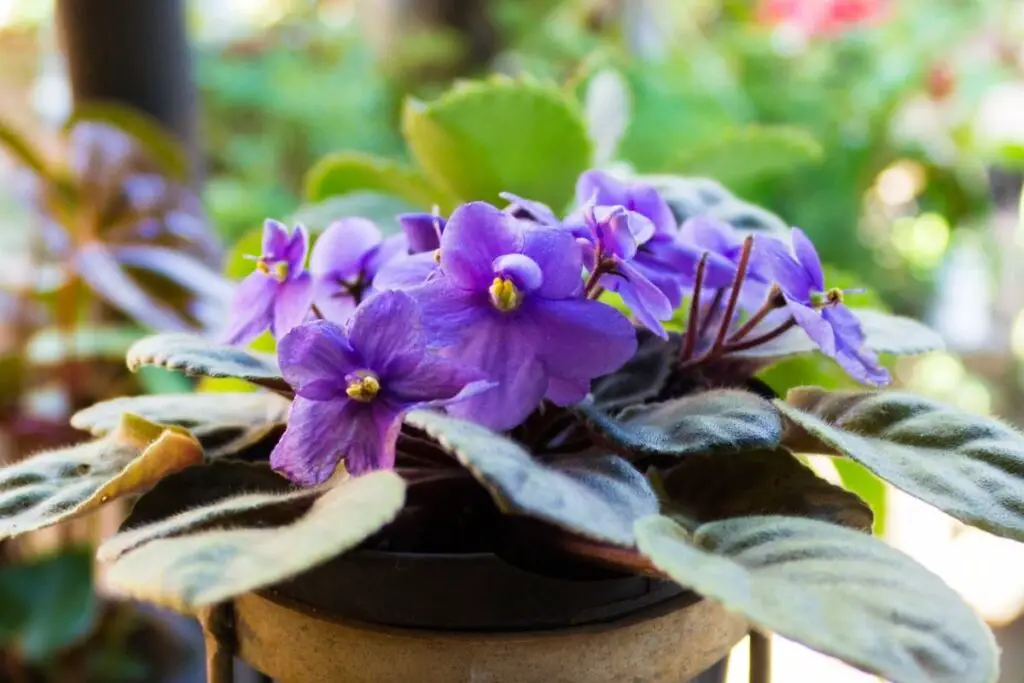
Tips for taking care of African violets
Taking care of African violets will not seem daunting if you know the proper care method.
1. Provide the right growing environment to your African violets
African violets should be grown indoors and not in the gardens as these plants hardly survive outdoors. Extreme conditions such as too hot and too cold climates can make your African violets undergo many problems.
African violets need indirect sunlight and humid conditions. Making them stay outside can cause damage as they need protection from the sun’s direct heat.
Various pests can also attack and damage the African violets if they are living outside. It is best to keep your African violets indoors as it becomes easy to manage or control them.
Also read: Where Do You Put African Violets? (Ideal Spot)
2. Provide sufficient indirect sunlight
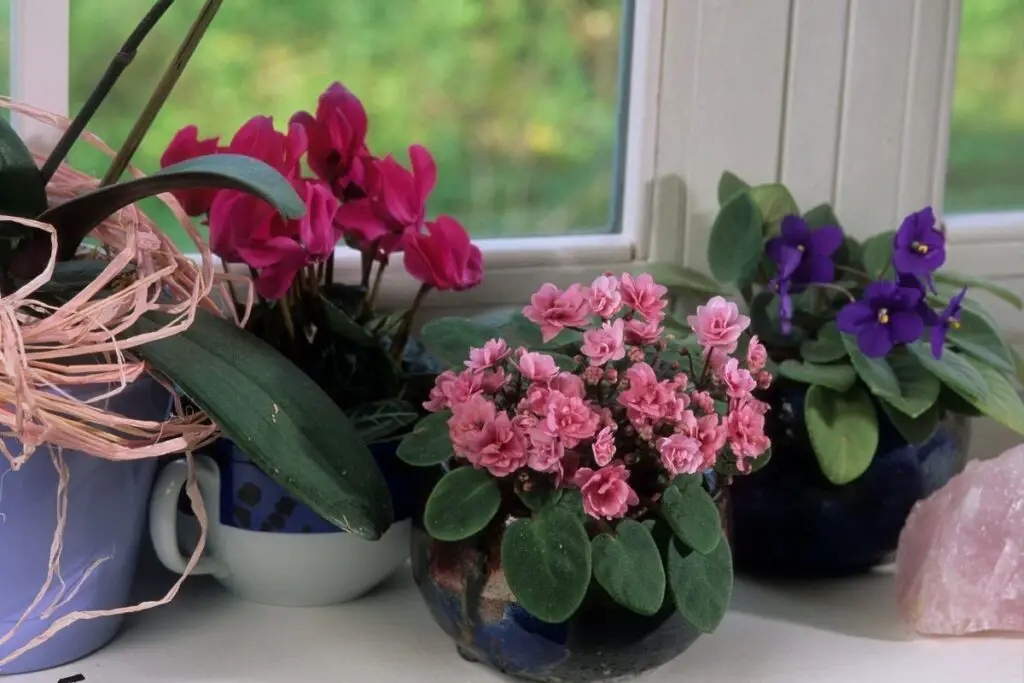
Providing your African violets with proper indirect sunlight is necessary for their healthy growth. You should never expose this plant to direct light.
African violets cannot tolerate direct heat as it can directly hamper their growth and cause too much moisture loss from the foliage. The plants will then struggle to survive due to rapid moisture loss.
If your African violets are exposed to direct light, you will get to see brown and discolored leaves. To keep this species healthy, you should provide at least 10-14 hours of indirect sunlight to them.
During the winter months, move your African violets near an east-facing window to provide them with enough sunlight.
Whereas, during the summer months, move your African violets near a north-facing window to avoid the risk of sunburn.
African violets cannot survive much in low light conditions because the chances of pest infestation and root rot increase due to damp soil.
You should carefully choose the plant’s location where they will get enough indirect sunlight without the risk of sunburn. If your plant is still not getting enough light, you can also provide artificial light for the plant.
Also read: What Kind Of Light Does An African Violet Need? (African Violet Light Requirements)
Looking for gardening supplies? We have tested 100's of products before recommending them to you guys. Check out our best pick below:
| Image | Gardening Supplies | Best Price? |
|---|---|---|
 Top
Top Top
Top | Raised Garden Bed Kit | Check On Amazon |
 | XLUX Soil Moisture Meter, Plant Water Monitor, Soil Hygrometer Sensor for Gardening, Farming, Indoor and Outdoor Plants, No Batteries Required | No Results |
 Top
Top Top
Top | 82 Pcs Garden Tools Set and Extra Succulent Tools Set | Check On Amazon |
 | Joeys Garden Expandable Garden Hose with 8 Function Hose Nozzle, Lightweight Anti-Kink Flexible Garden Hoses, Extra Strength Fabric with Double Latex Core, (50 FT, Black) | No Results |
 Top
Top Top
Top | Dual Chamber Compost Tumbler | Check On Amazon |
 Top
Top Top
Top | Sunnyglade Plant Stakes | Check On Amazon |
 Top
Top Top
Top | Organic Cold Pressed Neem Seed Oil | Check On Amazon |
 Top
Top Top
Top | Mighty Mint Gallon :-Insect and Pest Control Peppermint Oil | Check On Amazon |
 Top
Top Top
Top | Scotts DiseaseEx Lawn Fungicide | Check On Amazon |
 Top
Top Top
Top | Jacks Classic 20-20-20 All Purpose Fertilizer | Check On Amazon |
 Top
Top Top
Top | 30,000 Seeds Pollinator Attracting Wildflower Mixture | Check On Amazon |
 Top
Top Top
Top | Survival Vegetable Seeds Garden Kit-Over 16,000 Seeds | Check On Amazon |
3. Give African violets adequate and deep watering
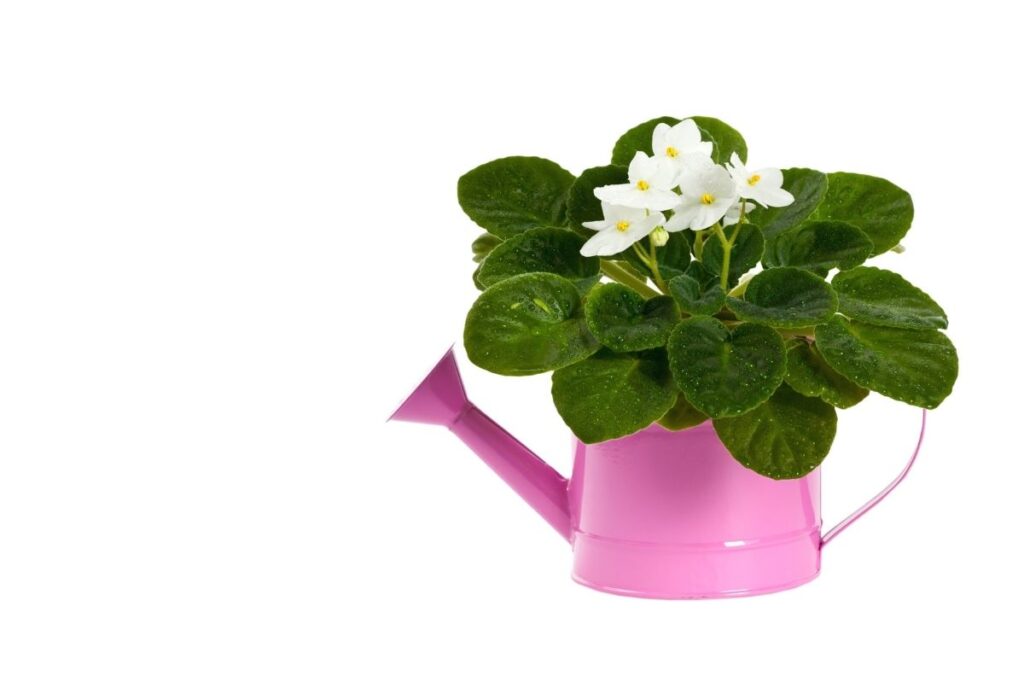
Provide sufficient and deep water for bringing out the best in African violets. In most cases, these plants experience overwatering, due to which the plant fails to grow properly and dies.
The roots of this plant need enough air to grow properly and survive, which soggy soil doesn’t allow, thus killing these plants. On the other hand, underwatering can also create a massive problem in African violet’s growth.
You must always check the soil’s moisture level with your index finger before watering. If the soil is still moist, you must wait for a few days. It is best to water them when the soil is dry to avoid the problem of overwatering.
While watering, you must soak the soil thoroughly until the excess water comes out from the pot. You can water your plant from the top but make sure you don’t wet the leaves and avoid using cold water on them.
You can also apply an easy method to give them the required water by placing the pot in a container with 2.5 cm of water in it.
Take it out from the water after 20 minutes or until the soil is thoroughly moist. Don’t let your African violets stand in water for too long, as it can increase the chances of root rot.
The watering schedule should match your plant’s needs, and you should never water before checking the soil’s moisture level.
Also read: How Often Should African Violets Be Watered? (African Violet Water Requirements)
4. Fertilize your African violets properly during the growing season
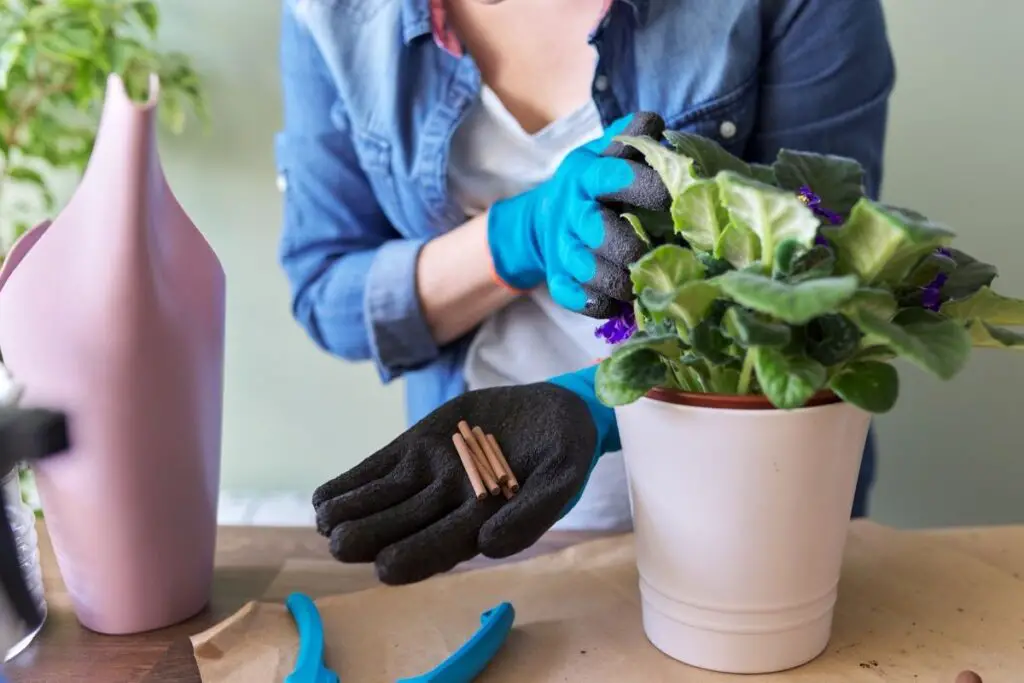
Fertilizing your plant is very necessary for its proper growth. If you don’t provide them enough fertilizer, they will lack energy, and their growth will stop.
If you want healthy African violets, you have to fertilize them adequately during the growing season.
The best time to feed this plant with fertilizer is during the spring and summer because they grow actively during that time. You should reduce your fertilization when the fall arrives as the growth becomes slower.
It is time to stop fertilizing during the winter months as it is their dormancy period, and the growth stops entirely for a while.
African violets mainly need nutrients like nitrogen, phosphorous, and potassium. Provide a well-balanced fertilizer with N-P-K of 15-30-15 to keep them healthy.
Make sure you don’t over-fertilize as the chemicals can damage the roots of these plants. Always try to use a liquid fertilizer and add enough water to them but do not go overboard.
When your African violets are growing actively during spring and summer, fertilize them every two weeks.
Also read: What Kind Of Fertilizer Is Good For African Violets? (+Best Picks)
5. African violets require the correct soil mix
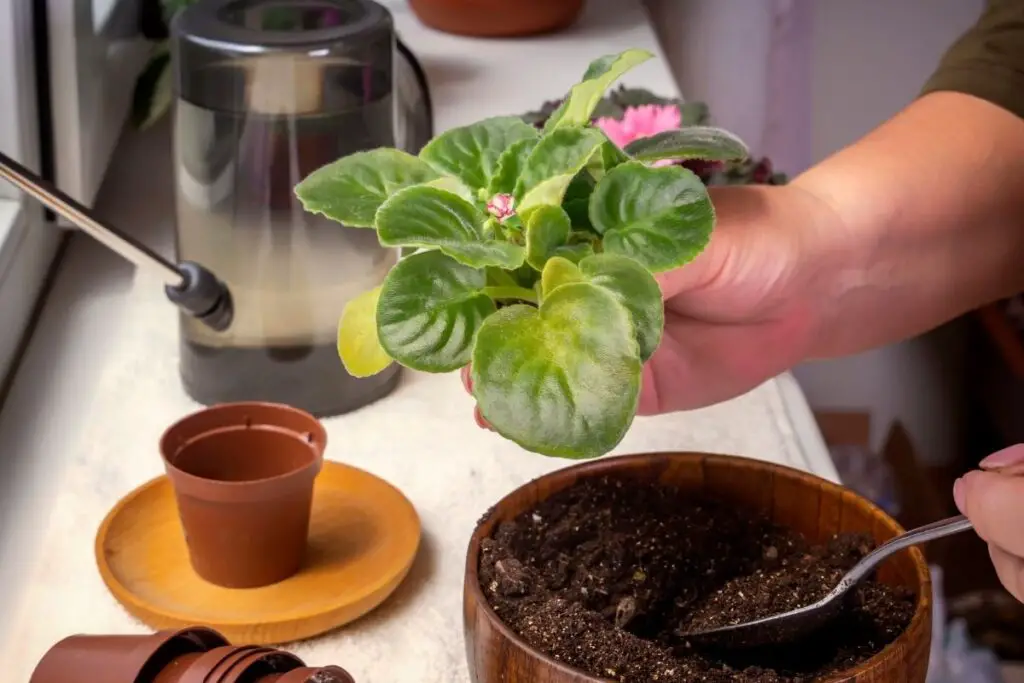
Soil mix plays a vital role in the development of African violets. If you find that the soil is too heavy or dense, it means your African violets are experiencing overwatering.
Wrong soil mix will create a poor drainage system in African violets, and the oxygen will not pass in the root system, leading to root rot disease.
Always use light and well-draining soil to hold enough moisture, and the excess water will drain out quickly from the pot. You can use peat-based soil, which includes perlite, compost vermiculite, and peat in the ratio of 25:25:25:25.
African violets prefer somewhat acidic soil with a pH value of 5.8 and 6.2. Always try to check and maintain the pH level of the soil. Choose the soil mix carefully with the proper nutrients to maintain the health and growth of African violets.
Also read: What Kind Of Soil Is Best For African Violets? (+Best Soil Mix)
6. African violets enjoys a higher humidity level
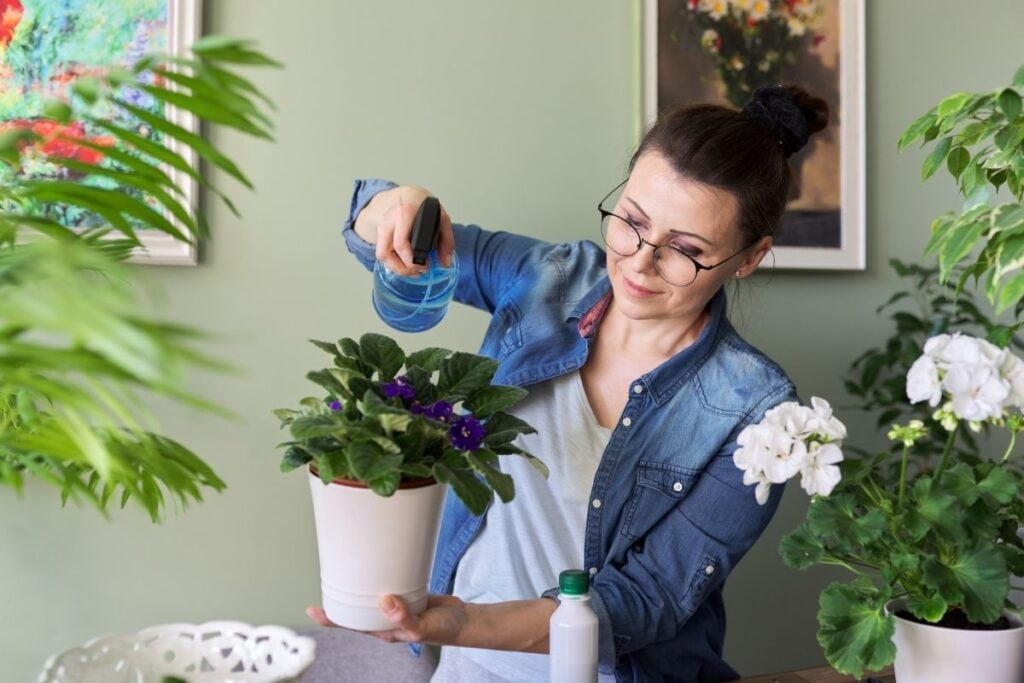
African violets require a humidity range between 55% and 65% or even more. If the humidity goes below 50%, it will be too dry for them, and it will become challenging for them to survive such conditions.
Humidity is necessary for regulating the process of photosynthesis. If the humidity is low, plants experience dehydration as they lose water from their leaves by transpiration.
You should maintain the humidity level inside your house to promote the growth of your African violets. You can maintain humidity levels by using a device called a humidifier.
Other ways of increasing humidity are by keeping other plants together with African violets, spraying water on your plants, or creating a pebble tray for them.
You can also place your African violets in the bathroom or basement as these areas have a humid environment. African violets experience low humidity problems during the winter season, so they require special care.
Also read: Do African Violets Like Misting? (+Humidity Guide)
7. Protect African violets from cold temperatures and keep them away from cold drafts
African violets mostly thrive in warm temperatures. If the temperature is not suitable, it becomes difficult for African violets to grow well. These plants mostly face problems when the temperature is cold.
Extreme cold temperatures can cause direct damage to the foliage and roots of plants. African violets thrive when the temperatures are around 65-80°F. During cold nights, keep these plants away from the windows or close them to protect them from frosts.
You can maintain temperature by using a thermostat device inside your home. You can also spread 2 to 3 inches of mulch over the soil surface.
Placing them near a fireplace can also help to increase the temperature of the African violets.
During cold conditions, try to provide indirect sunlight as much as possible to your African violets and decrease the watering rate.
Also read: African Violet Winter Care: Lighting, Watering, Fertilizing & More
8. Always repot your African violets once or twice a year
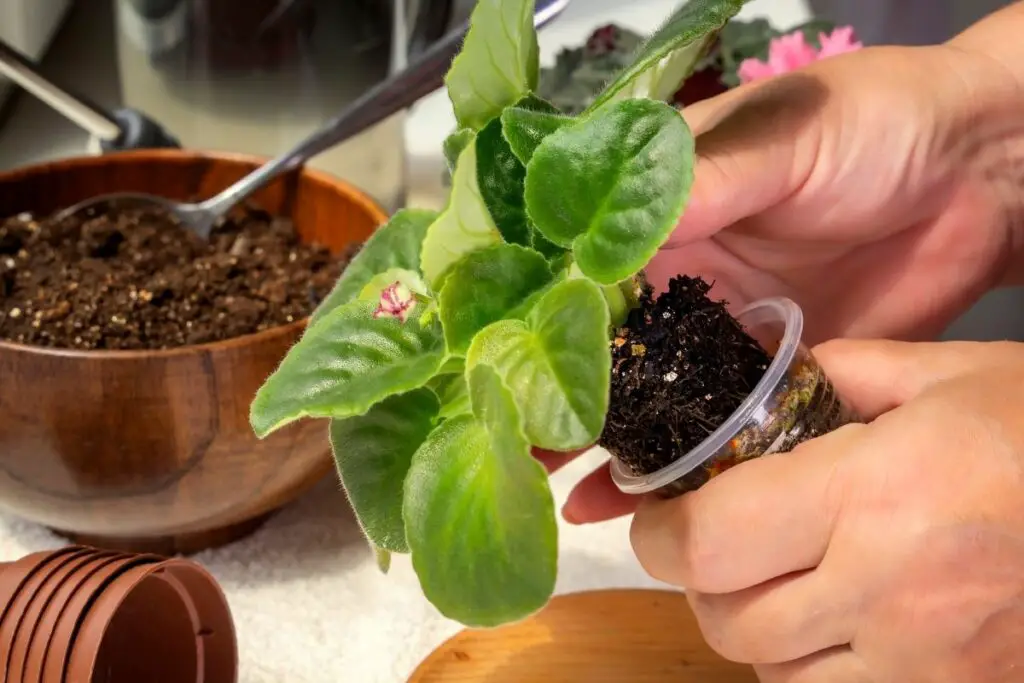
African violets need repotting for more blooms and growth. This process keeps the roots healthy, and the plant remains nutritious. Repotting helps to keep diseases and infections away from the plant and also improves the soil quality.
You should repot them once or twice per year. If you don’t repot your African violets, the roots will get suffocated and crowded. Because of less space in the roots, the plants will have stunted growth which may kill them.
One more reason, repotting is necessary because the soil, with time, becomes acidic and loses all of its nutrients, and repotting them in a fresh new soil mix will provide enough nutrients as compared to before.
While repotting, always choose a larger pot than the previous one to provide enough space for the roots.
If your African violets have become too large and you are finding difficulty in repotting, you can also replace 2 to 3 inches of the top layer of soil every year and add fresh potting mix on the top.
Also read: Do African Violets Like To Be Root Bound? (When To Repot)
9. Keep your African violets in the right-sized pot
The size of the pot is essential for healthy African violets. If the pot is too small, it restricts the growth of the roots due to a lack of space. And if the pot is too large, it will hold more water and result in overwatered plants.
Both small and big pots can create problems for African violets. You need to choose pots carefully while planting your African violets or repotting them with the new ones.
Choose the pot which will be 1/3rd diameter of the plant. That means the pot should be three times bigger in diameter than the size of the plant.
You should also check that your pot has a sound drainage system.
Also read: What Kind Of Pot Does An African Violet Need? (Pot Type+Size)
10. Protect your plant from pests by spraying with an organic solution
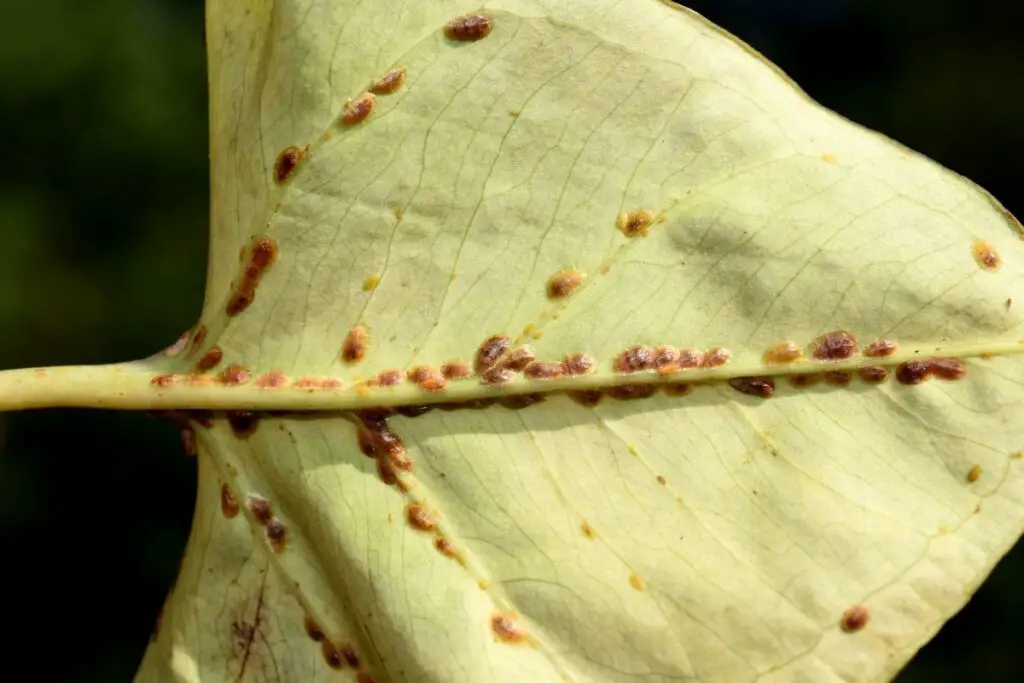
Various pests can attack your African violets. They mainly attack because of wet conditions. Pests like mealybugs, cyclamen mites, and thrips can get attracted to your African violets.
These pests take away all the nutrients from the African violet’s leaves by sucking out the sap and weakening the plants. If pests have already attacked your plants, spray neem or horticulture oil to get rid of them. You can also use insecticidal soap while spraying.
If you don’t want any pests to attack your African violets, spray neem or horticulture oil once a month.
Also read: How To Get Rid Of Bugs On African Violets? (Signs+Treatment)
11. Prune your African violets often
Pruning encourages new growth and helps in maintaining the natural shape and size of your African violets.
You should always prune off extended plant areas and old blooms to encourage them to grow more beautifully. Lack of pruning can invite any kinds of pests, which can essentially damage your plants.
Pruning also helps to get rid of already damaged leaves and prevents them from spreading further. You should prune African violets every week to keep them healthy.
Always remove the diseased, dead, old blooms, discolored or soft leaves, and avoid cutting the main stem. You can pinch them off or use sterilized scissors to cut them.
Also read: How To Prune African Violets? (Step-by-Step Guide)
12. Propagate the African violets to get more plants out of it
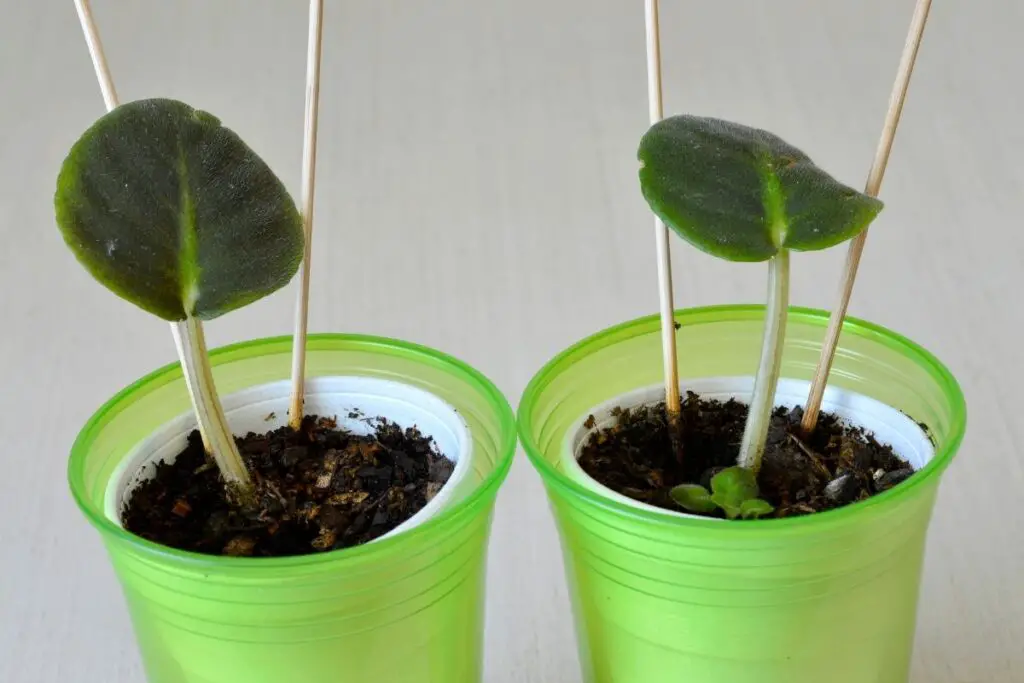
If your African violet’s health is deteriorating or you want more of them, you can propagate them.
For propagating your African violets, choose a healthy and fresh-looking leaf. Then take a sharp object and cut the leaf or stem at a 45 degrees angle about 1 or ½ an inch in length.
After that, take a pot, fill it with loose and light potting mix, and place your leaf stem inside the soil mix. Provide indirect sunlight, and the leaf will start growing in a month.
Once the roots start to grow, wait for a few days and then repot the new plants.
Also read: How To Propagate African Violets? (By Leaf, Water & Soil)
Final words
With all these tips that also explain the basic requirements of the African violets, you can develop a care routine that suits these plants the best. With some attention and care, the African violets will reward you with beautiful blooms.
However, you must set realistic goals with your African violets. The plants might face challenges, and you must be ready to treat and cure them rather than give up on them. Taking preventive measures can also save your African violets from unnecessary troubles.
Source: Wikipedia, African violet: Classical breeding, African Violet Society of America, In vitro propagation of African violet, University of Florida, North Dakota State University, The University of Georgia.
